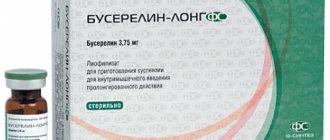Oxytocin for uterine bleeding
16.02.2018
DANGEROUS! Self-medication with oxytocin is unacceptable.
Uterine bleeding occurs in women of all ages. If such conditions occur, you should immediately consult a doctor, as significant blood loss is life-threatening.
Only a doctor can assess a woman’s condition, establish the cause of the pathology, assess possible risks, and determine a treatment regimen. Oxytocin for uterine bleeding is prescribed as one of the hemostatic drugs.
Uterine bleeding occurs for various reasons. To facilitate diagnosis, they are divided into two categories:
- Non-genital (or extragenital) are associated with dysfunction of various physiological systems and individual organs:
- blood diseases;
- liver dysfunction;
- infections;
- problems of the circulatory system;
- disruption of the hematopoietic process;
- failure of thyroid secretion.
- Genital are associated with disruption of the functioning of the organs of the reproductive system. In this group, pathological conditions are divided into pregnancy-related or unrelated.
The main types of uterine blood loss are classified based on the reasons that provoked the development of the pathological condition:
- Dysfunctional. They are associated with disruption of the ovaries in women of different ages, so they are divided into juvenile (in teenage girls), reproductive, and menopausal. They are characterized by an increase in the volume of menstrual blood, longer periods - up to 7 days or more. There is an acyclic nature of dysfunctional blood loss. Periods of absence of menstruation alternate with heavy menstrual flow.
- Organic. Associated with pathologies of internal organs.
- Iatrogenic. They develop against the background of the use of pharmaceuticals - hormonal contraceptives, drugs against thrombosis, as well as cytostatics, corticosteroids and others.
Regardless of its origin, bleeding cannot be avoided without medical attention. Therapeutic measures are aimed not only at stopping heavy bleeding, but also at identifying and eliminating the main cause that caused the dangerous pathological condition.
When bleeding occurs between periods, you need to call an ambulance. You should not try to stop bleeding at home, especially when the blood is released intensely. Before the doctor arrives:
- lie down, place a cushion or pillow under your feet;
- apply cold to the lower abdomen;
- drink more fluids.
If bleeding is associated with diagnosed pathologies and the doctor has prescribed appropriate medications, you can take hemostatic agents.
Even if there is only a single case of bleeding between periods, you need to consult a gynecologist. You cannot self-medicate.
It is very difficult to determine metrorrhagia (uterine bleeding) if it occurs during menstruation. Its distinctive features:
- bleeding continues for more than a week;
- general weakness;
- sharp pain in the lower abdomen;
- copious discharge;
- nausea;
- dizziness;
- low blood pressure;
- discharge of bright scarlet blood;
- occurs suddenly after intense physical exertion, stress, sexual intercourse, or due to other factors.
Causes of metrorrhagia
The most common causes of metrorrhagia are:
- hormonal disorders;
- infections and inflammations of the internal organs of the reproductive system;
- neoplasms in the uterus, ovaries;
- ectopic pregnancy;
- rupture of an ovarian cyst;
- uterine fibroids;
- genital injuries;
- use of contraceptives;
- menopause
Bleeding during pregnancy develops at any time. They are called:
- self-abortion;
- frozen pregnancy;
- abruption or placenta previa.
If there is bleeding in a pregnant woman, an ultrasound is prescribed to determine the viability of the fetus. Drugs that stop bleeding are prescribed if the examination results are positive. After induced termination of pregnancy, hemostatic drugs (for example, oxytocin) are prescribed to contract the uterus, to reduce the risk of uterine bleeding.
Oxytocin
Hormonal medication is prescribed only by the attending physician. The stimulating effect of oxytocin on the uterus is used to terminate pregnancy in the early stages, to stimulate weak labor, and to quickly separate the placenta after childbirth if it does not come out naturally.
During their reproductive years, many women experience the phenomenon of uterine bleeding. Pathology can be provoked by diseases of the genitourinary system or banal overwork of the body.
One of the proven remedies for heavy blood loss is Oxytocin. This remedy is actively used in gynecology to stop various bleeding.
Oxytocin instructions for using injections for uterine bleeding, how to use them and whether they can be used without a doctor’s prescription.
Uterine bleeding is pathological bleeding of the uterus. Pathology can appear both during menstruation and between menstruation.
It can sometimes be quite difficult to distinguish pathology from normal menstruation, but a deviation can be suspected by the following symptoms:
- Menstruation for more than 8 days.
- Bad feeling.
- Pain in the pelvic area.
- Large volume of blood released.
- Low blood pressure.
- The appearance of spotting after sports or sex.
If the bleeding occurs suddenly and the blood loss is significant (the woman changes the pad every hour), urgently call for emergency help. You should not take any hemostatic agents on your own. Stopping blood should only be carried out in a hospital setting.
Menstrual flow is an individual bleeding schedule for each woman. Many women have heavy periods, but this is not considered a pathology. The amount of blood released can depend on many factors, such as physical activity, taking certain medications, or your emotional state. Normal menstruation can be considered discharge that has the following symptoms:
- Menstruation begins with small discharge.
- Your period peaks on the 2nd or 3rd day of your period.
- Then the amount of blood gradually decreases.
- On the 7th or 8th day, menstruation stops.
The presence of dark-colored clots, streaks and mucus in the blood can also be considered normal. Pain is also normal during menstruation. They are of a pulling or aching nature, and sometimes cramping pain can be felt.
IMPORTANT! There cannot be severe unbearable pain during menstruation! If these deviations appear, immediately call an ambulance.
Most often, uterine bleeding occurs in women of childbearing age for the following reasons:
- Severe stress.
- Heavy physical activity.
- Insufficient rest.
- Diseases of the reproductive system.
- Uncontrolled use of hormonal drugs.
- Infections.
- Insufficiency of the pituitary gland.
- Endocrine diseases.
- Tumors.
- Erosive damage to the cervix.
- Childbirth and termination of pregnancy.
- Hormonal age-related changes.
Most of the above reasons are the result of a negligent attitude towards one’s health. Women should remember that untimely treatment of diseases, strong feelings and physical stress can negatively affect their body. At the first deviations in the menstrual cycle, you should definitely visit a gynecologist so that the disorder does not develop into a dangerous pathology.
The first result of uterine bleeding can be a serious form of anemia. This is a blood disease in which the amount of hemoglobin is reduced. It is this substance that is responsible for supplying oxygen to all organs and tissues. As a result of chronic hypoxia, vital organs begin to malfunction. Necrosis of cells, including the brain, is observed.
During acute bleeding, a woman may lose too much blood, which without timely assistance can be fatal.
Uterine bleeding is different. They are classified according to the reason they occur. Today doctors distinguish the following types of this deviation:
- Dysfunctional - bleeding resulting from disturbances in the functioning of the ovaries. Characterized by an increase in the time and volume of menstruation. There may also be a change in prolonged periods and their absence for several months.
- Organic - a deviation caused by a blood disease or pathologies of internal organs. This deviation is observed in leukemia, thrombocytopenia, fibroids, endometriosis, polyps, etc.
- Iatrogenic - a deviation caused by taking certain groups of drugs. It may occur during treatment with anticoagulants, hormones, cytostatics, etc.
Oxytocin instructions for the use of injections for uterine bleeding state that the drug has a narrowly targeted effect and can only be used in cases of uterine hypotonicity. Oxytocin is a synthetic hormonal agent used in obstetrics for decreased contractility of the uterus during childbirth, miscarriages, abortions and uterine bleeding.
The use of Oxytocin for uterine bleeding is justified only when metrorrhagia is caused by weakness of the uterine muscles. The drug does not help with abnormalities caused by inflammatory diseases, tumors, blood pathologies or dysfunction of the gonads. Oxytocin is also used with caution for bleeding caused by hormonal imbalances.
Properties of the drug
The synthetic form of Oxytocin has a vasoconstrictor effect. As a result, the tone of the uterus increases. When the drug is administered, the smooth muscles of the uterus, intestines, gallbladder and bladder contract.
During labor, Oxytocin can ease contractions and speed up the birth process. After the birth of a child, the administration of the drug accelerates the contraction of the uterus and the removal of the placenta, increases the volume of milk produced and stops uterine bleeding.
Only a doctor should prescribe Oxytocin during childbirth. If labor proceeds normally, an excess of the hormone in the body can cause a deterioration in blood flow to the tissues of the uterus and placenta. Lack of oxygen due to poor blood supply causes birth injuries.
The use of Oxytocin as a hemostatic agent is not recommended for patients with the following diseases:
- Myocardial inflammation.
- Atherosclerosis.
- Diseases of the genitourinary system.
- Spasms of cerebral vessels.
- Kidney failure.
- Hypertension.
Dosages for liquid solution
The doctor selects the Oxytocin treatment regimen for uterine bleeding individually, depending on what specifically caused the problem, the characteristics of the patient’s body, etc. Most often:
to stop bleeding after an abortion or childbirth, use up to 1.5 cm of 3 medications three times a day, for a course of up to 3 days;
for heavy menstrual bleeding - intravenously using 500 cm 3 of glucose to 1 cm 3.
In the latter case, the duration of the course of therapy is determined by the attending physician. Before using this drug, the patient should be given a saline solution without oxytocin. Patients should not administer the drug too quickly. This is fraught with the development of bronchospasm, and in some cases even death.
According to the instructions for use, Oxytocin injections in certain situations can also be prescribed to patients to prevent the development of bleeding, when there is an increased risk of their occurrence. In this case, a patient with reduced uterine tone is usually prescribed up to 1 cm 3 of the drug. The preventive course can last up to 21 days.
How to stop bleeding during menstruation
Pathological flow of blood from the genital organs of the fair sex occurs at any age.
Uterine bleeding is irregular bleeding from the uterus that is longer or more severe than during normal menstrual cycles. This is a fairly serious symptom associated with a number of disorders caused not only by gynecological diseases.
Knowing how to stop bleeding can help you take the necessary steps to prevent serious and possibly life-threatening complications associated with the symptom.
How to determine?
Uterine bleeding is abnormal if:
- Menstruation occurs more often than every 21 days, or the menstrual cycle lasts more than 35 days. The normal adult menstrual cycle ranges from 21 to 35 days, and the teenage one – from 21 to 45 days.
- Menstruation lasts more than 7 days. Normal menstruation usually lasts from 4 to 6 days.
- Blood loss is heavier than normal, amounting to more than 80 milliliters during one menstrual cycle.
- When bleeding occurs, blood clots appear that soak pads or tampons every hour for 2 or more hours.
If you have one or more of these symptoms, the bleeding is considered serious and you should consult a doctor.
Due to heavy or constant bleeding, the following may develop over time: decreased hemoglobin levels in the blood (anemia), fever, shortness of breath, pale skin, dizziness. Also, with blood loss, weakness or fatigue often appears, and appetite is lost. In this case, a thorough assessment of women's health and consultation with a gynecologist is necessary.
You should also use watchful waiting if:
- a thorough examination reveals no physical problems or illnesses;
- the blood loss is not severe enough to cause anemia (anemia);
- there is a desire to wait and see if the symptoms that arise gradually improve;
- in adolescence, there is a possibility that menstrual cycles will even out over time;
- The age of menopause is approaching and you can expect the bleeding to stop soon.
If, during vigilant anticipation, severe, acute, abnormal uterine bleeding appears and hygiene products cannot cope with its volume, in this case, urgent hospitalization and consultation with a gynecologist are required.
Bleeding of this type is a serious pathology, which is quite dangerous to treat on your own. If symptoms have recently appeared, or there are signs of the onset of heavy blood loss, you should immediately consult a doctor.
If your physical condition does not allow you to see a doctor yourself, you need to call an ambulance at home.
How can you stop uterine bleeding at home before the ambulance arrives:
- It is recommended to remain in bed and move with caution so as not to provoke increased bleeding. It is advisable to place a tall soft object under your feet to drain blood from the lower part of the body.
- It is also recommended to place something cold on the lower abdomen, for example, ice, meat from the freezer, a bottle of cold water wrapped in a cloth. These measures will help narrow the blood vessels and partially reduce blood loss.
- While on bed rest, it is important to drink enough fluids to replace fluid lost by the body and reduce symptoms of anemia. The best thing for this is tea with sugar and rosehip decoction to replenish glucose and improve blood clotting.
When taking urgent measures, you cannot:
- perform vaginal douching;
- take a bath, especially a hot one;
- warm the stomach with heat, including a warm heating pad;
- take medications without a doctor's recommendation.
These measures can provoke the development of inflammation or intensify existing symptoms.
The question often also arises of how to stop bleeding at home due to uterine fibroids, during pregnancy, or for other established causes.
Reference. Bleeding due to uterine fibroids or other diseases can be stopped at home in the same way as normal uterine bleeding can be stopped. To carry out the procedures, you must call an ambulance at home.
Drugs
Only the attending physician can prescribe medicinal treatment that stops blood loss in these cases after conducting an appropriate study of the state of women's health.
Etamsylate (Dicinone). A hemostatic drug that increases blood clotting, improves its microcirculation, and increases the stability of capillaries. It is used intramuscularly or in tablet form. Contraindications – allergies, low blood pressure, thrombosis, pregnancy, lactation. Cost: Etamzilat-Ferein solution for 125 mg/ml 2 ml – 75 rub./pack.
Oxytocin. This hormonal drug stimulates the contractile activity of the uterus, increases its tone, and has the property of retaining water in the body.
When used intravenously with glucose, it effectively stops blood loss.
Contraindications – pregnancy, heart rhythm disturbances, increased uterine tone, presence of a scar on the uterus, hypersensitivity to the drug, allergies. Cost: Oxytocin solution 5IU/ml 1ml – 45 RUR/pack.
Calcium gluconate. Participates in the process of blood clotting, supports cardiac activity, reduces vascular permeability, and has a moderate diuretic effect.
It is not a first-line drug in the fight against pathology, but it improves the general condition of the body. Contraindications: hypercalcemia, renal failure, thrombosis, hypersensitivity to the drug.
Cost: Calcium gluconate tablets 500 mg – 40 rubles/pack.
Traditional methods
To cope with severe symptoms of the disorder, supplementation with bioflavonoids (vitamin C companions) and vitamin E may be helpful.
Taking vitamin K, which enhances blood clotting, is effective.
Folk remedies often help to completely stop or temporarily stop uterine bleeding using hemostatic herbs such as yarrow, as well as witch hazel and blue cohosh. These funds strengthen the circulatory system and are used for the prevention and treatment of this pathology.
For uterine bleeding, use the following recipe for preparing yarrow herb: pour 1 cup of boiling water over 1 tbsp. l. herbs and cook it over low heat for 20 minutes. Then leave for 1 hour, strain and take 1 tbsp. l. three times a day after meals.
Preparation of a medicinal infusion based on witch hazel: dry witch hazel in the volume of a heaped teaspoon is poured with a glass of boiling water and infused for 10 minutes. Then the infusion is boiled for 10-15 minutes and after infusion is filtered. The infusion is taken for 3-4 days, 2-3 glasses per day between meals.
Ashoka tree bark is considered useful for treating diseases of the female reproductive system and is used as a powerful healing and sedative. To prepare an infusion from the bark of the Ashoka tree, you need to boil the bark in milk, after diluting the milk with water. Drink the infusion twice a day.
Video on this topic
This natural remedy is effective in treating these symptoms.
For uterine bleeding, a diet rich in iron and vitamins A and C is very useful.
It is also important to increase your consumption:
- whole grains;
- sardines, tuna, salmon fish;
- fresh ripe fruits, green vegetables, legumes.
These measures help replenish the body with the substances it needs, as well as combat the symptoms that arise.
Another way to stop uterine bleeding at home is to avoid eating rich meats including beef, chicken, cheese, etc.
Consuming the required amount of iron-containing foods provides immune protection to the body and prevents iron deficiency anemia.
Another effective way to stop bleeding is to take brewer's yeast or wheat germ once a day with a regular meal, which helps in conditions of a noticeable increase in blood loss.
If you delay contacting a specialist during an exacerbation of the disease, vascular circulation may occur. This, in turn, can cause uncontrolled blood loss and the need for urgent resuscitation measures.
Complications of the disease also include the development of iron deficiency anemia, decreased quality of life and subsequent long-term treatment.
Conclusion
Uterine bleeding can pose a serious risk to a woman's health if not treated promptly. Loss of blood can cause hemorrhagic shock, and prolonged and heavy bleeding can trigger the development of uterine cancer.
Treatment of the disorder is carried out only after its cause has been accurately established. As a rule, the prognosis for treatment in this case is favorable. Also, for disorders associated with uterine bleeding, doctors recommend regular examination by a gynecologist to prevent possible relapses of the disease.
If uterine bleeding occurs, we must not forget that all issues of its cause and stop are within the competence of the doctor. However, it is also necessary to know what hemostatic agents are used and what can be done to provide first aid.
The following steps will help stop uterine bleeding at home:
- Place the woman in bed on a flat surface with the foot end raised. This will reduce blood flow to the pelvic organs, but improve blood circulation to the brain and chest organs.
- Place cold on your stomach; a plastic bag with ice or a special rubber bladder or a heating pad with cold water is best. The cold can be kept for up to 2 hours, but with 5-minute breaks every 15 minutes.
- Provide the woman with fluids. You can give still mineral water, not hot or strong sweet tea, sweetened drinking water. Pharmaceutical glucose-saline solutions (rehydron, glucosolan and analogues) are well suited; they will help avoid fluid loss, the development of brain hypoxia and cardiovascular failure.
Without a doctor's prescription, you should not give any medications until the cause of the bleeding is determined, including antispasmodics and painkillers.
You cannot douche, administer suppositories, or apply heat to relieve pain. Even if the bleeding is not profuse, a woman should not perform any exercise, have sexual intercourse, or take a shower or bath.
Important
Of course, when using this product, the instructions for use must be strictly followed. Reviews of Oxytocin injections indicate that the procedure is very painful. In addition, this medicine is considered quite “heavy” and dangerous.
According to the rules, injections of this drug, including intramuscular ones, can only be given by medical professionals. You cannot self-administer Oxytocin during uterine bleeding (metrorrhagia). Those patients treated with these tablets should consult a doctor immediately if symptoms such as:
change in heart rate;
If used incorrectly, this drug can cause severe bleeding or uterine rupture.
Hemostatic agents for cuts
To prevent blood loss due to mechanical damage to soft tissues, local medicinal hemostatic agents are used. Minor cuts and wounds on the skin can simply be treated with hydrogen peroxide to disinfect. The foaming effect of peroxide can stop mild capillary bleeding. A more severe case requires the use of drugs with enhanced hemostatic effect.
Convenient to use hemostatic powder with anesthetics. The main active ingredient adrenaline has a vasoconstrictor effect, which achieves the effect of stopping minor bleeding in case of superficial damage. Preparations for external treatment of wounds are made from specially treated human or animal blood.
Side effects
You should not self-medicate with the drug “Oxytocin” for uterine bleeding, among other things, also because it can in some cases have a strong negative effect on the patient’s body. This medicine may cause side effects, for example:
spasms in the bronchi;
sharp or too intense contractions of the uterus;
cerebral hemorrhage;
sudden surges in pressure;
While taking the drug, the doctor must constantly monitor the patient's condition. This is especially true for blood pressure and heart rate.
For hemorrhoids
Sudden bleeding caused by a rupture of the hemorrhoid can be stopped with the help of hemostatic agents used for other types of blood loss (Ditsinon, Vikasol, Etamzilat, etc.). In addition, an effective drug is Relief, which is available in the form of suppositories and ointments. Oils, glycerin and vitamin complex, which are the basis of suppositories, have wound healing and hemostatic properties. Using suppositories to block blood flow on an ongoing basis is contraindicated.
For local anesthesia and stopping local bleeding from anal fissures, you can use a hemostatic self-absorbing sponge soaked in a solution of targeted drugs. The introduction of suppositories and sponges helps to quickly eliminate bleeding, but you should not count on a long-term effect.
Contraindications for use
Before prescribing the hormonal drug Oxytocin, the gynecologist must carefully examine the patient’s medical history and anamnesis. Only such measures will help prevent various serious complications. It is important for women to familiarize themselves with the list of contraindications, even after the doctor has prescribed injections. Complex therapy with Oxytocin will help cope with serious health problems and avoid negative consequences.
Oxytocin is not prescribed in the following cases:
- the impossibility of giving birth naturally, so doctors recommend a cesarean section (the drug is administered after surgery into the uterine muscle in case of heavy uterine bleeding);
- progressive stage of gestosis (the appearance of swelling, increased blood pressure, the appearance of seizures and loss of protein);
- diagnosis of feto-placental insufficiency, so the child is born ahead of schedule;
- strong Rh conflict between the pregnant woman and the fetus;
- pathological location of the placenta, so girls experience bleeding;
- chronic hypoxia;
- uterine sepsis or infection;
- allergic reactions to individual components of Oxytocin;
- renal failure;
- high blood pressure.









